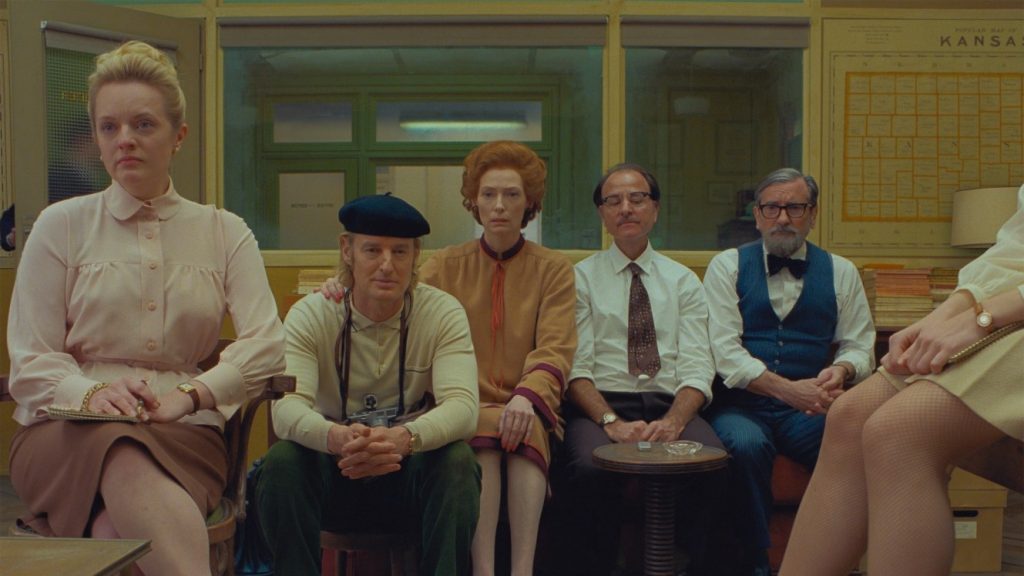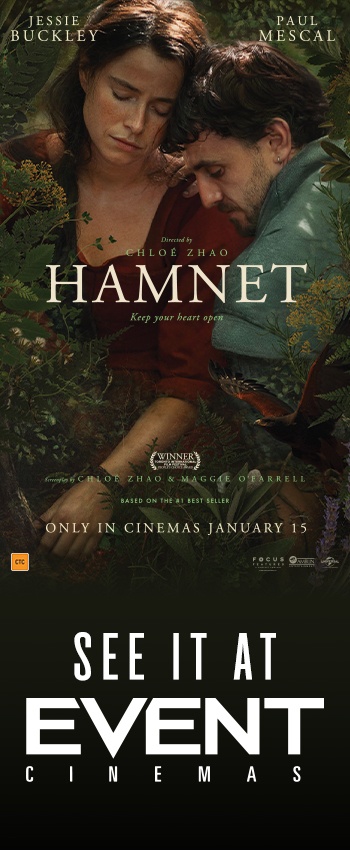One of the most remarkable things about Wes Anderson is his ability to draw large crowds of millennials to an art deco cinema in Leederville on a school night for a film that hasn’t even come out yet. This feat is even more impressive when you consider the recent summation of an older filmmaker regarding this demographic and our “fucking cellphones” preventing us from wanting to go to the movies. There must be something about the quaint rendering of ultra-symmetrical, pastel coloured diorama stories that appeals to us, for when I arrived early for the advanced screening of Anderson’s new film The French Dispatch, it appeared I was already late.
Set in Ennui-sur-Blasé (a French sister to the little-known English town Boredom-on-Apathy), The French Dispatch of the Liberty, Kansas Evening Sun spans several stories from the titular newspaper’s publication. Its editor-in-chief, Arthur Howitzer Jr. (Bill Murray – who else?), is based in part on The New Yorker’s Harold Ross due to Anderson’s great love of the paper’s short story section in his youth. Howitzer has just died from a sudden heart attack and his will stipulates that the newspaper is to cease publication upon his death, after one farewell edition which will feature three republished articles from past editions and an obituary for its fallen leader. As such, the film is broken up into three main stories and an epilogue, following an introductory tour of the town from The Cycling Reporter, Herbsaint Sazerac (Owen Wilson).
As Sazerac bicycles through Ennui (actual French town Angoulême – known as “la ville de l’Image” for its hefty contribution to France’s animated film industry) we see Anderson’s recycled miniature sets and street photography that emphasises the change that takes place in the town over the decades. Wilson’s characteristic voice and the point-of-view angle through which we experience this charming place help to blend the familiar with the new. He describes the undesirables of this town with affection, in particular the “rotting choir boys half drunk on the blood of Christ” and the “old people who have failed”. When Howitzer suggests that the story needs a reprieve from the doom and gloom – perhaps a flower shop – Sazerac replies “I hate flowers.” This response perfectly encapsulates the dynamic Howitzer’s writers had with him and the freedom he allowed them, further examined in the three stories to come.
In preparation for the first article ‘The Concrete Masterpiece’, artist Sandro Kopp had to create, in two months, paintings that would pass as having been painted by a genius over three years. Anderson instructed that he “do one where you attack it with a knife when you are done”, an appropriate command considering that the painting’s on-screen creator is incarcerated murderer Moses Rosenthaler (Benicio Del Toro). Rosenthaler’s work is illuminated by his subject, muse and prison guard Simone (a fantastic Léa Seydoux) and catches the eye of an art dealer played by Adrien Brody – a role similar to that of his Boy with Apple-less character in Grand Budapest. The article’s writer J.K.L Berensen (Tilda Swinton at her most Aardman-like) presents her piece by lecture, hilariously including (by mistake, or perhaps not) a very personal slide in her show. Her absurdity contrasts with the more authentic relationship between Rosenthaler and Simone, as del Toro and Seydoux’s chemistry bleeds onto the screen.
Where the flow wanes a little is the second article – ‘Revisions to a Manifesto’. Journalist Lucinda Krementz (the always brilliant Frances McDormand) follows a student protest in 1968 and gets a little closer with the follicly-blessed Zeffirelli (Timothée Chalamet) than I’m sure many Zoomers would like. But she doesn’t just share her bed with the young revolutionary; her contributions to his manifesto might render him in trouble with the plagiarism police as his writings curiously begin to take on a more mature tone. While this segment makes less of an impact at a storytelling level, the set design, cinematography and general creativity are so beautifully evident that the film seems to break from its confines and becomes a richly detailed theatre production.

The gang mourns their publishing Papa
Alexandre Desplat’s tickly piano score proves once again that he understands exactly the world Anderson is creating. Vintage interludes from Gus Viseur and Ennio Morricone bring nostalgia for a time and place many of the film’s audience weren’t even alive for, but pay homage to the many inspirations Anderson cites in the making of this film. In a genius marketing move, magazine copies of the fictional publication were handed out at the screening for all to enjoy (and some to sell on eBay), tangible proof of the effort expended and the further reading recommended about the trailblazing directors and journalists who’ve meant so much to the filmmaker.
What I love about Anderson’s filmography is that everyone seems to have a different favourite (The Darjeeling Limited until I die) and there’s always something to connect with, depending on where you’re at in your life. When I watched Moonrise Kingdom for the first time I saw two silly kids running off into the wilderness together. Watching it again recently, I found it more moving and focused than any of his other films. The masterful blending of comedy and melancholy in The Grand Budapest Hotel makes it perhaps Anderson’s most accomplished film, and those who didn’t shed a tear when rhetorically asked “whatever happened to man’s best friend” in his most recent canine caper should seriously ponder their status as human. The risk of making an anthology film is losing that level of emotional connection and there were indeed moments in The French Dispatch where I could feel my brow furrow with the worry that this might be the one whose substance finally succumbs to its style. And then came Jeffrey Wright.
The last of the three stories, entitled ‘The Private Dining Room of the Police Commissioner’, is recounted by Roebuck Wright (JW), a most loquacious writer and food critic with a typographic memory. Wright eloquently remembers (on a 70s talk show hosted by Liev Schreiber) an eventful dinner he had with Mathieu Amalric’s Commissaire and a police officer moonlighting as a world class chef. The sequence features gorgeous black and white cinematography, a slapstick chase involving Edward Norton, Saoirse Ronan’s electrically blue eyes, and exquisite illustrative animation reminiscent of Sylvain Chomet’s The Illusionist (and a host of earlier French films I haven’t seen). But it’s Wright’s performance that tops it all. Hints at his poetic rhythm were evident only to a pleb like me from his characters in Boardwalk Empire and Westworld – little did I know he is a Tony award-winning thespian.
Leave it to Wes to go harder in an anthology film than he’s ever gone before. A quick peek at the poster will amaze at how many cast members (returning and new) he manages to fit in while still forming a relatively cohesive overall product. It’s appropriate, then, that his editor-in-chief’s catchphrase is “try to make it sound like you wrote it that way on purpose.” Critics not charmed by the whimsy of his filmography may feel that Anderson is always just compiling (the cast, the camera framing, the colour palette, the comedic formula) but here he has done something quite personal. Whether the fictional death of his most consistent collaborator is meant to signal a kind of self obituary or he’s just trying to do something a bit different, there can be no doubt that it was the substance of those short stories that first captured Wes Anderson.
One could say that all of Anderson’s films are love letters to something but The French Dispatch is more than just an ode to a publication – it’s a sonnet to cinema itself. 8/10.




